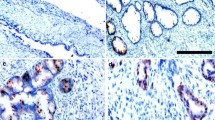Abstract
Objectives
Overexpression of a ubiquitous lysosomal aspartyl protease cathepsin D (cath-D) is involved in the progression of certain cancer types. This study investigated the prognostic value of the cath-D expression and its association with other known clinicopathological parameters in serous ovarian carcinoma.
Materials and methods
Cath-D was detected by immunohistochemistry in 49 serous ovarian carcinomas and compared to 50 benign serous ovarian tumors. The results were correlated with clinicopathological characteristics and survival outcomes.
Results
In both cath-D positive benign and malignant serous ovarian tumors, a specific granular cytoplasmic staining was observed in both epithelial and stromal cells. Cath-D expression levels were higher in serous ovarian carcinomas than in benign tumors (P < 0.01). Cath-D expression in tumor epithelial cells correlated with mesenchymal cell expression (P < 0.001). The cath-D expression levels of tumor epithelial cells correlated with residual tumor size (P = 0.027) and was not related to other factors (P > 0.05). Patients with higher cath-D expression in epithelial cells had longer disease-free survival time (DFST; P = 0.025) and overall survival time (OST; P = 0.030). Through the Cox regression test, we found that the response to treatment (P < 0.001), pathological stage (P < 0.001), and peritoneal cytology results (P = 0.018) were independent effect factors for DFST. The expression level of cath-D in epithelial cells (P = 0.025), response to treatment (P < 0.001), pathological stage (P = 0.001), and peritoneal cytology results (P = 0.002) were independent effect factors for OST.
Conclusion
This showed that cath-D was an indicator of malignancy in serous ovarian carcinoma. It was expressed more highly in serous ovarian carcinoma than benign serous ovarian tumor. Additionally, our results suggested that high expression of cath-D in tumor epithelial cells was a favorable survival prognostic factor for serous ovarian carcinoma.



Similar content being viewed by others
References
Bell DA (2005) Origins and molecular pathology of ovarian cancer. Mod Pathol 18(Suppl 2):S19–S32
Nomura T, Katunuma N (2005) Involvement of cathepsins in the invasion, metastasis and proliferation of cancer cells. J Med Invest 52(1–2):1–9
Clinton GM, Hua W (1997) Estrogen action in human ovarian cancer. Crit Rev Oncol Hematol 25(1):1–9
Berchem G, Glonda M, Gleizes M et al (2002) Cathepsin-D affects multiple tumor progression steps in vivo: proliferation, angiogenesis and apoptosis. Oncogene 21(38):5951–5955
Leto G, Tumminello FM, Crescimanno M et al (2004) Cathepsin D expression levels in nongynecological solid tumors: clinical and therapeutic implications. Clin Exp Metastasis 21(2):91–106
Rochefort H (1992) Cathepsin D in breast cancer: a tissue marker associated with metastasis. Eur J Cancer 28A(11):1780–1783
Foekens JA, Look MP, Bolt-de Vries J et al (1999) Cathepsin-D in primary breast cancer: prognostic evaluation involving 2810 patients. Br J Cancer 79(2):300–307
Henzen-Logmans SC, Fieret EJ, Berns EM et al (1994) Ki-67 staining in benign, borderline, malignant primary and metastatic ovarian tumors: correlation with steroid receptors, epidermal growth factor receptor and cathepsin D. Int J Cancer 57(4):468–472
Baekelandt M, Holm R, Trope CG et al (1999) The significance of metastasis-related facts cathepsin-D and nm23 in advanced ovarian cancer. Ann Oncol 10(11):1335–1341
Scambia G, Panici PB, Ferrandina G et al (1994) Clinical significance of cathepsin D in primary ovarian cancer. Eur J Cancer 30A:935–940
Ferrandina G, Scambia G, Fagotti A et al (1998) Immunoradiometric and immunohistochemical analysis of cathepsin D in ovarian cancer: lack of association with clinical outcome. Br J Cancer 78(12):1645–1652
Athanassiadou P, Sakellariou V, Petrakakou E et al (1998) Cathepsin D immunoreactivity in ovarian cancer: correlation with prognostic factors. Pathol Oncol 4(2):103–107
Losch A, Schindl M, Kohlberger P et al (2004) Cathepsin D in ovarian cancer: prognostic value and correlation with p53 expression and microvessel density. Gynecol Oncol 92(2):545–552
Nisolle M, Casanas RF, Donnez J (1997) Immunohistochemical analysis of proliferative activity and steroid receptor expression in peritoneal and ovarian endometriosis. Fertil Steril 68(5):912–919
Dvalishvili I, Charkviani L, Charkviani T et al (2005) Clinical prognostic factors and expression of cathepsin D in endometrioid adenocarcinoma. Georgian Med News 126:27–31
Rodríguez J, Vázquez J, Corte MD et al (2005) Clinical significance of cathepsin D concentration in tumor cytosol of primary breast cancer. Int J Biol Markers 20(2):103–111
Abbott DE, Margaryan NV, Jeruss JS et al (2010) Reevaluating cathepsin D as a biomarker for breast cancer: serum activity levels versus histopathology. Cancer Biol Ther 9(1):23–30
Maygarden SJ, Novotny DB, Moul JW et al (1994) Evaluation of cathepsin D and epidermal growth factor receptor in prostate carcinoma. Mod Pathol 7(9):930–9366
Holm R, Tanum G (1996) Evaluation of the prognostic significance of nm23/NDP kinase and cathepsin D in anal carcinomas. An immunohistochemical study. Virchows Arch 428(2):85–89
Axel SM, Joerg H, Perikles S et al (2005) Translational research: from lab to clinic: cathepsin D expression in renal cell cancer clinical implications. Eur Urol 48:519–526
Conflict of interest
No actual or potential conflict of interest in relation to this article exists.
Author information
Authors and Affiliations
Corresponding author
Rights and permissions
About this article
Cite this article
Chai, Y., Wu, W., Zhou, C. et al. The potential prognostic value of cathepsin D protein in serous ovarian cancer. Arch Gynecol Obstet 286, 465–471 (2012). https://doi.org/10.1007/s00404-012-2318-2
Received:
Accepted:
Published:
Issue Date:
DOI: https://doi.org/10.1007/s00404-012-2318-2




